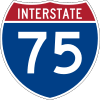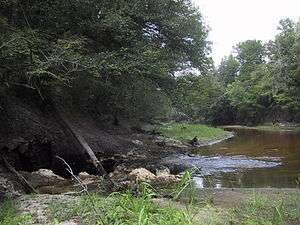The Alapaha River is a 202-mile-long (325 km)[1] river in southern Georgia and northern Florida in the United States. It is a tributary of the Suwannee River, which flows to the Gulf of Mexico.
History
The Hernando de Soto expedition narrative records mention a "Yupaha" village they encountered after they left Apalachee, "the sound of which is suggestive of the Alapaha, a tributary of the Suwanee."[2] Another reference to a village of "Atapaha" "so closely resembles Alapaha that it is reasonable to suppose they are the same, and that the town was on the river of that name."[3] John Reed Swanton's landmark Indian Tribes of North America places the Indian village of Alapaha near where the Alapaha River met the Suwanee, and also noted that an Indian village of "Arapaja" was 70 leagues from St. Augustine, Florida, probably on the Alapaha River.[4]
In the 1840s a German travel writer, Friedrich Gerstäcker wrote a dime novel called Alapaha, or the Renegades of the Border, giving the name to a noble Cherokee "squaw." A translation of this novel was published in the 1870s as #67 in a series of American narratives published by Beadle.[5]
During the American Civil War, the swamps along the Alapaha River in Berrien, Irwin, and Echols counties became a refuge for a number of gangs of Confederate deserters.[6]
Course
The Alapaha River rises in southeastern Dooly County, Georgia, and flows generally southeastwardly through or along the boundaries of Crisp, Wilcox, Turner, Ben Hill, Irwin, Tift, Berrien, Atkinson, Lanier, Lowndes and Echols Counties in Georgia, and Hamilton County in Florida, where it flows into the Suwannee River 10 miles (16 km) southwest of Jasper. Along its course it passes the Georgia towns of Rebecca, Alapaha, Willacoochee, Lakeland, and Statenville.
Near Willacoochee, Georgia, the Alapaha collects the Willacoochee River. In Florida, it collects the Alapahoochee River and the short Little Alapaha River, which rises in Echols County, Georgia, and flows southwestward.
Intermittent river
The Alapaha River is an intermittent river for part of its course. During periods of low volume, the river disappears underground and becomes a subterranean river. At approximately 2.3 miles (3.7 km) downstream from Jennings, Florida is a river sinkhole variously known as the Alapaha River Sink, Suck Hole, or the Devil's Den on the western bank of the river. It is located at 30°35′08″N 83°03′10″W / 30.5855009°N 83.0528016°W / 30.5855009; -83.0528016. A short distance away from the Devil's Den's, the Dead River enters into the Alapaha River. It is a usually dry river bed with a number of sinkholes, including the Dead River Sink.
A few more miles downstream is a second sinkhole known as the Dead River Sink or the Siphon. At the latter point during the periods of low water flow, the Alapaha River disappears underground leaving a dry bank for much of the remainder of its course. The Alapaha River later reappears at the Alapaha River Rise, which is about a half mile upstream from the confluence of the Alapaha River and the Suwanee River (30°26′46″N 83°05′51″W / 30.446044°N 83.097483°W / 30.446044; -83.097483). During a period of low rainfall over 11 miles (18 km) of the riverbed can be dry as the river goes underground.
Variant names
The United States Board on Geographic Names settled on "Alapaha River" as the stream's name in 1891. According to the Geographic Names Information System, it has also been known as:
- Alabaha River
- Alapa Haw River
- Alapa Hawchu River
- Alla-pa-ha River
- Allallehaw River
- Allapacoochee River
- Allapaha River
|
- Allapauhau River
- Allaphaw River
- Allappaha River
- Allopohaw River
- Alloppehaw River
- Alopaha River
- Elapaha River
|
- Lappahaw River
- Lop Haw River
- Lopaha River
- Lopahatchy River
- Loppahaw River
- Low Haw River
- Popaha River
|
Crossings
| Crossing |
Carries |
Image |
Location |
ID number |
Coordinates |
|
|
|
Griffin Road |
|
|
|
32°01′27″N 83°36′37″W / 32.0243°N 83.6103°W / 32.0243; -83.6103 |
| Buzzard Bridge |
Willford Crossing Road |
|
|
|
32°01′27″N 83°36′37″W / 32.0243°N 83.6103°W / 32.0243; -83.6103 |
|
County Line Road |
|
|
|
32°01′11″N 83°36′37″W / 32.0198°N 83.6103°W / 32.0198; -83.6103 |
|
Seville Road |
|
|
|
32°00′32″N 83°36′06″W / 32.0089°N 83.6016°W / 32.0089; -83.6016 |
|
Seville Road |
|
|
|
32°00′32″N 83°36′06″W / 32.0089°N 83.6016°W / 32.0089; -83.6016 |
|
Seville-Pleasantview Road |
|
|
|
31°59′50″N 83°35′27″W / 31.9973°N 83.5908°W / 31.9973; -83.5908 |
|
Old Cordele Road |
|
|
|
31°59′07″N 83°34′40″W / 31.9853°N 83.5778°W / 31.9853; -83.5778 |
|
Flowers Road |
|
|
|
31°58′39″N 83°34′34″W / 31.9775°N 83.5761°W / 31.9775; -83.5761 |
|
Watson Road |
|
|
|
31°58′01″N 83°34′38″W / 31.9670°N 83.5771°W / 31.9670; -83.5771 |
|
Dowley Road |
|
|
|
31°56′52″N 83°33′37″W / 31.9478°N 83.5604°W / 31.9478; -83.5604 |
| Rail bridge |
CSX Transportation
Line formerly known as Savannah, Americus and Montgomery Railway |
|
|
|
31°56′52″N 83°33′37″W / 31.9478°N 83.5604°W / 31.9478; -83.5604 |
|
 US 280 US 280
 SR 30 SR 30 |
|
Pitts, Georgia to Seville, Georgia |
|
31°55′52″N 83°33′10″W / 31.9312°N 83.5527°W / 31.9312; -83.5527 |
|
Highway later replaced by  SR 159 SR 159 |
|
|
|
31°55′52″N 83°33′10″W / 31.9312°N 83.5527°W / 31.9312; -83.5527 |
|
 SR 159 SR 159 |
|
|
|
31°55′49″N 83°33′07″W / 31.9303°N 83.5519°W / 31.9303; -83.5519 |
|
Hawkinsville and Florida Southern Railway (Abandoned 1920s) |
|
|
|
31°55′24″N 83°32′43″W / 31.9234°N 83.5453°W / 31.9234; -83.5453 |
|
 SR 112 SR 112 |
|
|
|
31°51′31″N 83°28′47″W / 31.8587°N 83.4797°W / 31.8587; -83.4797 |
|
Jay Calhoun Road |
|
|
|
31°51′31″N 83°28′47″W / 31.8587°N 83.4797°W / 31.8587; -83.4797 |
|
 SR 90 SR 90 |
|
Rebecca, Georgia |
|
31°46′17″N 83°27′17″W / 31.7714°N 83.4547°W / 31.7714; -83.4547 |
| Rail bridge |
CSX Transportation
Line formerly known as Atlanta, Birmingham and Atlantic Railway |
|
|
|
31°46′17″N 83°27′17″W / 31.7714°N 83.4547°W / 31.7714; -83.4547 |
|
Hawkinsville and Florida Southern Railway (Abandoned since before the 1920s) |
|
|
|
31°46′17″N 83°27′17″W / 31.7714°N 83.4547°W / 31.7714; -83.4547 |
|
 SR 107 SR 107 |
|
|
|
31°41′24″N 83°27′41″W / 31.6899°N 83.4615°W / 31.6899; -83.4615 |
| Walker Ford |
|
|
|
|
31°41′24″N 83°27′41″W / 31.6899°N 83.4615°W / 31.6899; -83.4615 |
| Flat Ford |
|
|
|
|
31°40′53″N 83°27′44″W / 31.6814°N 83.4621°W / 31.6814; -83.4621 |
|
Crystal Lake Road |
|
|
|
31°40′38″N 83°27′37″W / 31.6772°N 83.4602°W / 31.6772; -83.4602 |
|
 SR 125 SR 125
 SR 132 SR 132 |
|
|
|
31°31′58″N 83°23′56″W / 31.5327°N 83.3989°W / 31.5327; -83.3989 |
|
Tifton and Northeastern Railroad (Line abandoned in the 1960s, defunct) |
|
|
|
31°32′59″N 83°24′54″W / 31.5497°N 83.4151°W / 31.5497; -83.4151 |
|
 US 319 US 319
 SR 35 SR 35 |
|
|
|
31°31′58″N 83°23′56″W / 31.5327°N 83.3989°W / 31.5327; -83.3989 |
|
5 Bridge Road |
|
|
|
31°28′45″N 83°20′41″W / 31.4791°N 83.3447°W / 31.4791; -83.3447 |
|
 US 129 US 129
 SR 11 SR 11 |
|
|
|
31°25′49″N 83°14′44″W / 31.4303°N 83.2456°W / 31.4303; -83.2456 |
| Sgt. James E. Jones Memorial Bridge |
 US 82 US 82
 SR 50 SR 50 |
|
|
|
31°22′17″N 83°10′17″W / 31.3714°N 83.1713°W / 31.3714; -83.1713 |
| Rail bridge |
CSX Transportation
Line formally known as the Brunswick and Albany Railroad |
|
|
|
31°22′17″N 83°10′17″W / 31.3714°N 83.1713°W / 31.3714; -83.1713 |
| PVT. George W. Lee Memorial Bridge |
 SR 135 SR 135 |
|
|
|
31°18′11″N 83°03′12″W / 31.302988°N 83.053354°W / 31.302988; -83.053354 |
|
Norfolk Southern Railway
Line formerly known as Ocilla, Pinebloom and Valdosta Railroad |
|
|
|
31°03′14″N 83°02′23″W / 31.053811°N 83.039627°W / 31.053811; -83.039627 |
|
 SR 168 SR 168
 SR 64 SR 64 |
|
|
|
31°09′25″N 83°02′22″W / 31.156844°N 83.039514°W / 31.156844; -83.039514 |
|
Waycross and Western Railroad (Closed 1925, defunct) |
|
|
|
31°03′14″N 83°02′23″W / 31.053811°N 83.039627°W / 31.053811; -83.039627 |
| Captain Henry Will Jones Bridge |
 US 129 US 129
 SR 11 SR 11 |
|
Lakeland, Georgia to Homerville, Georgia |
|
31°02′46″N 83°02′36″W / 31.046217°N 83.043361°W / 31.046217; -83.043361 |
| Carters Ferry/Bridge |
(Defunct) |
|
Lakeland, Georgia to Magnolia, Georgia. |
|
|
| Hotchkiss Bridge |
Old State Road/Old River/Hotchiss Road (Built 1895, defunct) |
|
|
|
30°56′11″N 83°02′26″W / 30.936513°N 83.040614°W / 30.936513; -83.040614 |
|
 US 84 US 84
 SR 38 SR 38 |
|
Naylor, Georgia to Stockton, Georgia |
|
30°55′28″N 83°02′14″W / 30.924563°N 83.037216°W / 30.924563; -83.037216 |
| Rail bridge |
CSX Transportation
Line formerly known as the Atlantic and Gulf Railroad |
|
|
|
30°55′27″N 83°02′13″W / 30.924074°N 83.036841°W / 30.924074; -83.036841 |
| Lee Bridge |
(Defunct) |
|
|
|
30°51′30″N 83°01′25″W / 30.858398°N 83.023588°W / 30.858398; -83.023588 |
| Howells Ferry/Bridge |
Howell Road (Old route, defunct) |
|
Mayday, Georgia |
|
30°49′43″N 83°01′07″W / 30.828749°N 83.018640°W / 30.828749; -83.018640 |
|
Howell Road |
|
Mayday, Georgia |
|
30°49′41″N 83°01′07″W / 30.828193°N 83.018549°W / 30.828193; -83.018549 |
| Rail bridge |
Norfolk Southern Railway
Line formerly known as the Atlantic, Valdosta and Western Railway |
|
Mayday, Georgia |
|
30°49′37″N 83°01′06″W / 30.826888°N 83.018458°W / 30.826888; -83.018458 |
| Formally the location of Troublesome Ford |
 SR 94 SR 94 |
|
Statenville, Georgia |
|
30°42′14″N 83°01′58″W / 30.703908°N 83.032683°W / 30.703908; -83.032683 |
|
|
|
 SR 150 SR 150 |
|
Jennings, Florida to Jasper, Florida |
|
30°35′54″N 83°04′24″W / 30.598471°N 83.073230°W / 30.598471; -83.073230 |
| Rail bridge |
Norfolk Southern Railway
Line formerly known as Georgia Southern and Florida Railway |
|
|
|
30°35′53″N 83°04′24″W / 30.598135°N 83.073226°W / 30.598135; -83.073226 |
|
NW 14th Terrace (Defunct) |
|
|
|
30°35′37″N 83°03′55″W / 30.593586°N 83.065301°W / 30.593586; -83.065301 |
|
 US 41 US 41 |
|
Jennings, Florida to Jasper, Florida |
|
30°31′44″N 83°02′18″W / 30.528814°N 83.038319°W / 30.528814; -83.038319 |
|
 Interstate 75 Interstate 75 |
|
|
|
30°29′57″N 83°02′27″W / 30.499170°N 83.040930°W / 30.499170; -83.040930 |
|
(Defunct) |
|
|
|
30°27′12″N 83°05′22″W / 30.453340°N 83.089351°W / 30.453340; -83.089351 |
|
SW County Road 751 |
|
Alapaha River Rise |
|
30°26′55″N 83°05′49″W / 30.448605°N 83.096923°W / 30.448605; -83.096923 |
References
- ↑ U.S. Geological Survey. National Hydrography Dataset high-resolution flowline data. The National Map, accessed April 18, 2011
- ↑ George Ransford Fairbanks, History of Florida from its discovery by Ponce de Leon, in 1512 to the close of the Florida War in 1842. Philadelphia: J.P. Lippincott & Co., 1871, p. 60.
- ↑ Fairbanks, p. 76.
- ↑ John Reed Swanton, Indian Tribes of North America, p. 147.
- ↑ Alapaha, the squaw or, The renegades of the border [WorldCat.org]
- ↑ "Disgraceful". Albany Patriot. Albany, Georgia. 23 February 1865. Retrieved 2 September 2016.
External links
Significant waterways of Florida |
|---|
|
| Larger rivers | |
|---|
|
| Lakes | |
|---|
|
Smaller rivers
| |
|---|
|
Creeks and
streams | |
|---|
|
| Canals | |
|---|
|
| See also | |
|---|
|
|---|
|
| Larger rivers | |
|---|
|
| Lakes | |
|---|
|
Smaller rivers
| |
|---|
|
| Tidal rivers | |
|---|
|
Creeks and
streams | |
|---|
|
| Canals | |
|---|
|
| See also | |
|---|
Coordinates: 30°26′12″N 83°05′47″W / 30.4366062°N 83.0965262°W / 30.4366062; -83.0965262


